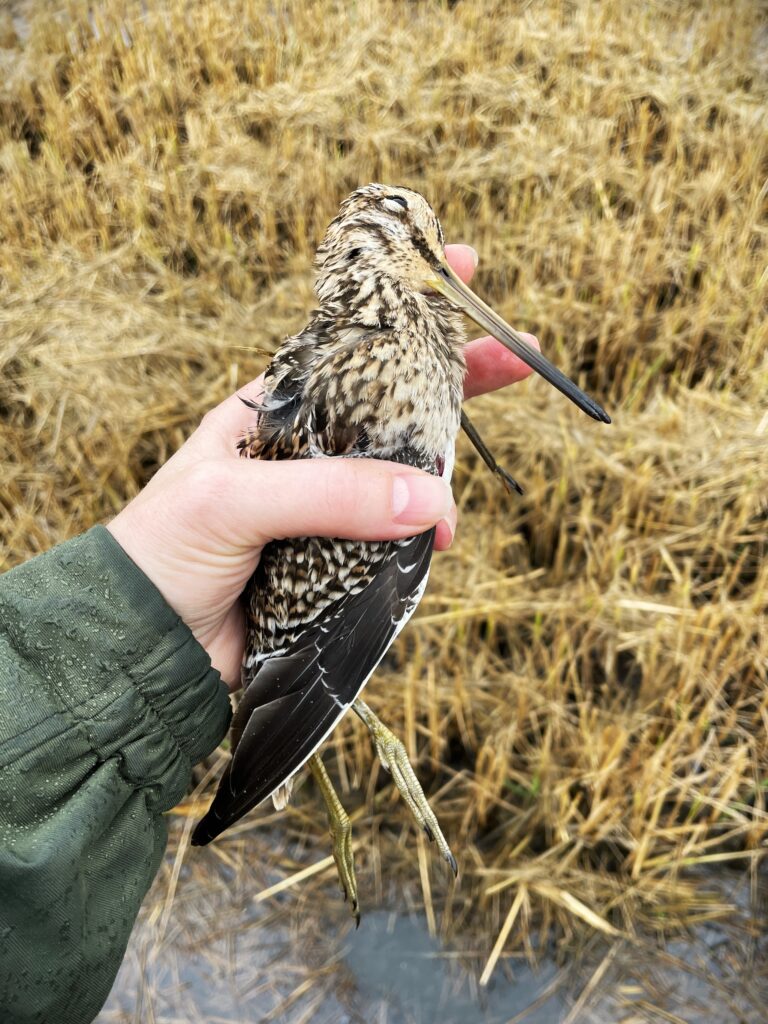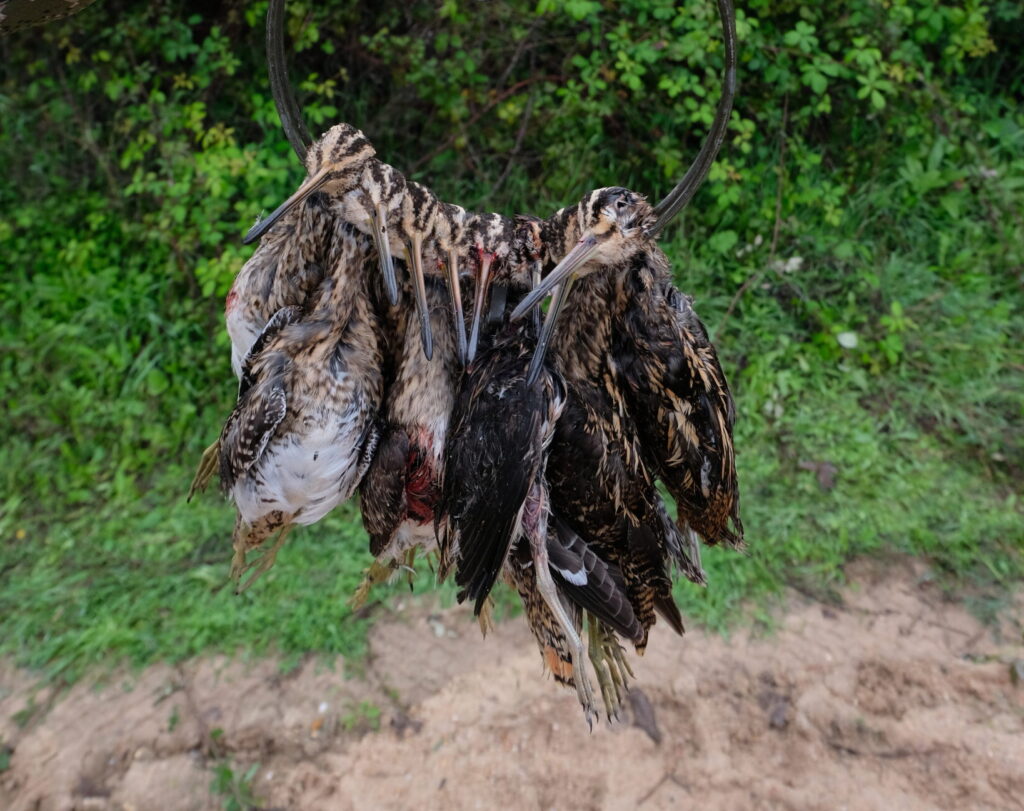Before we left Denmark, our Portuguese contact wrote that he was planning a hunt for snipes. Michael found a video on YouTube just to tune in on the challenge and said in a quiet voice: I think you are going to see me under pressure! Because in that video they claimed snipes to be the fastest gamebird in the world!
The Danish name for snipe is Bekkasin. And we talked about how it has a rhythmic sound to it, like a dance. And having watched them in action we agreed that it is a suitable description as the birds zig zags through the air as fast as the butt of a salsa dancer! Likewise, the English name Snipe gives you a sense of speed. Almost like getting hit by a rolled-up towel you didn’t see coming. Fortunately, the little bird doesn’t hurt. It is just fast!

But had I done my research before leaving home, I would have known that the snipe in other ways is kind of special. It turns out that the outermost part of the beak can open separately like lips. And I would have loved to take a closer look at that phenomenon while I actually had the bird in my hand.
Even though he often prefers hunts without a big trophy, just the simple or different experience in nature, snipe has never really been on Michael’s radar. Perhaps partly because the areas in Denmark where you find larger flocks of snipes mainly are protected areas where hunting is not allowed. Another reason is that there are two types of snipes called single and double snipe according to the length of the beak and the size of the bird, but in Denmark you are only allowed to hunt the larger one of them. Therefore, should a snipe take off in front of you, it will often be gone before you decide whether to take the shot or not. In Portugal you are allowed to hunt both.

Tough mudder
The day began after only four hours of sleep from the hunt for wild boar the previous night, and it turned out to be a wet day for two reasons; it was raining and Miguel had made an appointment with one of the largest producers of rice in Portugal. And man, we were working in the rice fields! At one point I was shaking and had tunnel vision because of low blood sugar and chose to take it out on a box of chocolate we brought as a gift for our hosts. Not one of my proudest moments, but I was desperate.


A plan that worked
Before the guys found the right strategy for searching through the terrain, they shot a few holes in the air and the atmosphere was… let’s say focused! The birds were simply too fast! Michael, Miguel and Miguel’s friend Nuno had been joking about the chances of me seeing three grown men crying that day. But Miguel have been snipe-hunting since he was a boy, so they cracked the code pretty fast.
The most efficient setup was not to walk through the field in a straight line, when you don’t hunt with pointing dogs that makes it possible to get closer to the bird. The biggest challenge when they took off in the direction away from the chain of shooters was the characteristic zig-zagging flight side to side. One way of compensation this was to use cartridge # 9 instead of # 4-7 that is often used for bird hunting, to get a higher pellet count per shot.

But still no guarantee of success. Everything Michael has learned about aiming in front of pheasants which also makes quite a rapid acceleration when taking off, should roughly be doubled because of the speed of the snipe.
Another thing that turned out to be effective was to let the line swing forward in a way that made the outermost shooter walking ahead of the line of men and dogs. That made it possible to get a good shot at the birds taking off away from the rest of us. From that angle the ever-changing direction of the snipes became less of a challenge for the hunter. Fortunately, that position was assigned to Michael.


Senses at work
It is definitely not an easy job for dog’s nose to find the snipes that went down. The bird in itself doesn’t carry much scent and the water is full of living as well as half eaten crayfish left by the big flocks of storks enjoying the large amounts of shellfish.
On our way to the hunting area, we saw line after line of electric cables each pole topped with a stork’s nest. We proudly told Miguel that the stork used to be the Danish national bird. But since the population of storks has drastically decreased it is not uncommonly on national news when couples of storks are breeding. Miguel was unimpressed. He said we could have all of them and that he gladly will deliver them personally! The challenges they have with storks seem similar to our challenges with cormorants. The birds are protected and live in such large numbers that their feces kill everything else in the habitats.

Unexpected surprices
One of the snipes Michael hit fell on the other side of a small canal and we had to ask for help from dog and man to find it. First Nuno tried to cross the canal but was stopped in the middle of a jump when his boots were indisputable stuck in the muddy clay! But he managed to escape and had his dog search for the fallen bird.
Because it took a while, Miguel approached with his dogs to help searching. Seeing the deep prints in the mud from Nuno’s boots he called Nuno “a little flower from the city” and continued with a cocky attitude to cross over… only to break down laughing when he had to ask Nuno for assistance to get unstuck!

While we were fooling around, the dogs never stopped working! One of them found the bird while the other one stayed at a large water pipe that went under the dirt road, making a very insisting sound.
None of us understood what he wanted until a fox sprinted from the other end of the pipe! I was in the way for a fast shot, but even though I instinctively sat down sat down, the fox was quickly out of range and made it to the trees at the end of the rice fields. The German short-haired dog Scot never realized what happened and wouldn’t give up his fox hunt! It demanded an effort keeping him out of the pipe to prevent him from getting stuck in there because of his long legs.

And yes there will be food!
When we were absolutely done in more than one way the landowner and his wife generously served a delicious local stew followed by a chocolate mousse from another world! It deserved to be documented. The memory of their homegrown and homemade olives stays with me, but we were simply too exhausted to think about taking photos and we were more than ready to sleep before 6 o’clock that evening with buzzing muscles in our legs and a smile on our faces.
Eleven birds down and eight of them found and retrieved was the total count on this very different and challenging hunting day filled with action, surprise and a little unplanned entertainment. While we are working our way through the rice fields Michael says with satisfaction: This is amazing! But I would never have chosen this kind of hunt myself!

Known vs. new?
You might have a tendency of choosing the classic or what is already known. If ever given the opportunity of trying a different kind of hunting, whether foreign or domestic, go for it! You might be surprised by the simple or just the differently challenging hunt. And it might also add to the experience when you know how to handle a shotgun. Michael hit 5 of the small feathered airborne ninjas!
From my perspective all this is the reward for being openminded to the world. Michael excels at meeting new people without expectations and just see what grows from there. At least well enough to receive and follow up one the invitation from someone you don’t know that well – yet!
Fortunately, we agree that hunting trips should make room for the planned as well as the spontaneous. Hopefully, you will harvest the benefit of the many hours of practicing and still learn and experience new. We both love encountering a different culture and the people in it. Our trip to Portugal had it all and we are just a few days from going again!
Can’t wait to see what Portugal has for us this time!


